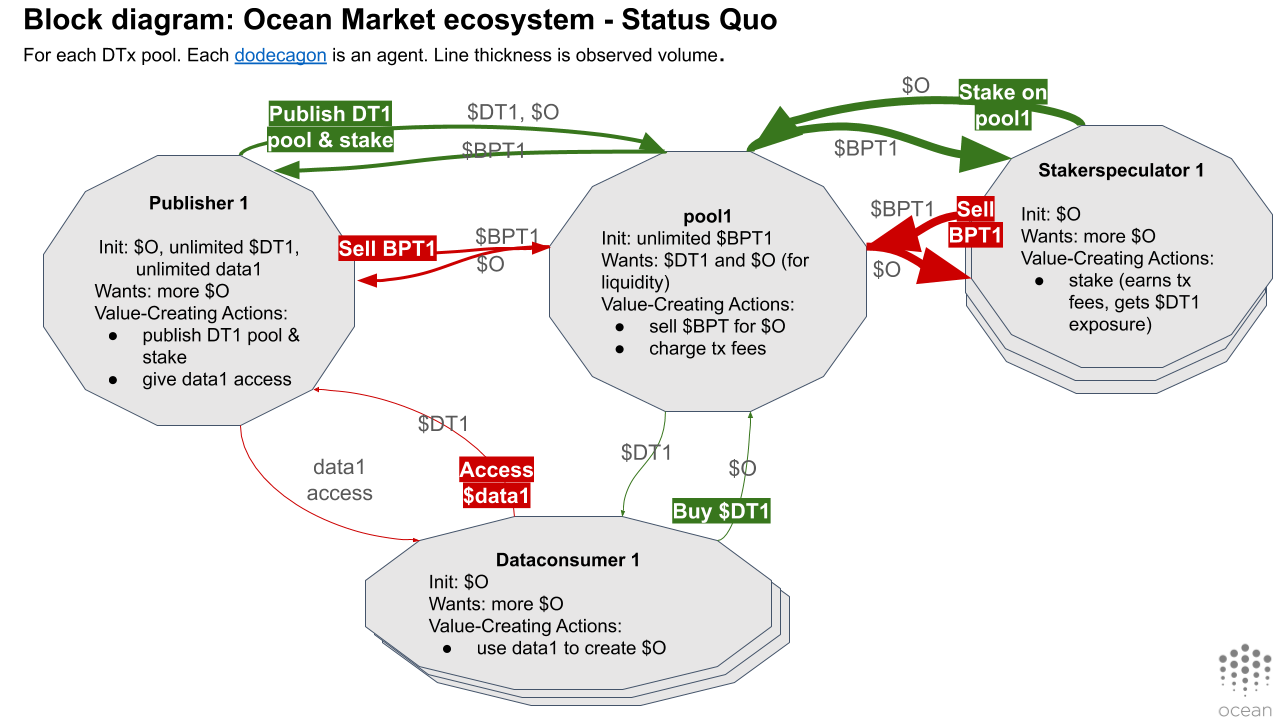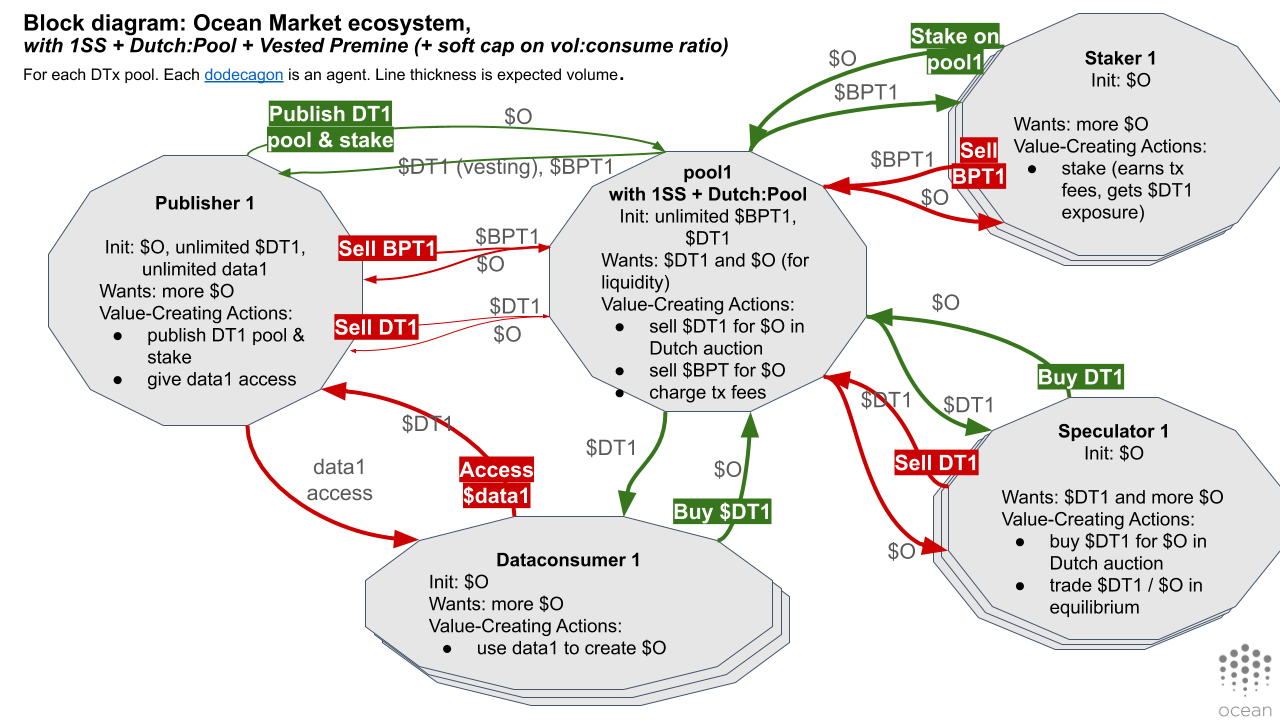This tokenSPICE fork is clean to fork, no additives or food coloring
TokenSPICE can be used to help design, tune, and verify tokenized ecosystems in an overall Token Engineering (TE) flow.
TokenSPICE simulates tokenized ecosystems using an agent-based approach.
Each “agent” is a class. Has a wallet, and does work to earn $. One models the system by wiring up agents, and tracking metrics (kpis). Agents may be written in pure Python, or with an EVM-based backend. (The original version was pure Python. I may merge this repo into the original at some point.)
It's currently tuned to model Ocean Market. The original version was tuned for the Web3 Sustainability Loop. However you can rewire the "netlist" of "agents" to simulate whatever you like. Simply fork it and get going.
TokenSPICE was meant to be simple. It definitely makes no claims on "best" for anything. Maybe you'll find it useful.
if you don't have ganache install it with npm
npm install -g ganache-cli
Open a new terminal and run ganache:
cd tokenspice2
./ganache.py
Note: you could run ganache directly, but then you have to add many special arguments. The script above does that for you.
git clone https://github.com/oceanprotocol/contracts
Then, deploy. In that same terminal:
cd contracts
yarn
yarn deploy(only do this for customn path, already set up)
Finally, open tokenspice/tokenspice.ini and set ARTIFACTS_PATH = contracts/artifacts.
- Now, TokenSPICE knows where to find each contract on ganache (address.json file)
- And, it knows what each contract's interface is (*.json files).
cd ..
pytest web3engine/test/test_btoken.pypytestUpdate simulation code. Open a new terminal. In it:
Run tests. In the same terminal as before:
pytestChange sim settings as needed.
- To run faster: open
tokenspice.iniand setsafety = False.
run
./run_1.py 10 output
Run simulation. Here, we run a 10-day sim, storing to outdir_csv. Observe the results while running. See help.py for more options.
rm -rf outdir_csv; ./run_1.py 10 outdir_csv 1>out.txt 2>&1 &
tail -f out.txt
Create plots from run results, and store them in `outdir_png`. Then view the images.
```console
rm -rf outdir_png; ./plot_1.py outdir_csv outdir_png
eog outdir_png
#finally, maybe import pngs into GSlides Then repeat previous steps as desired.
- All agents inherit BaseAgent
- Controllable agents use EVM.
- Uncontrollable agents use pure Python. But each has EOA.
- Therefore the core dynamics are still on-chain
- Each Agent has an AgentWallet.
- AgentWallet is the main bridge between higher-level Python and EVM.
- Each AgentWallet holds a Web3Wallet.
- The Web3Wallet holds a private key and creates TXs.
Controllable agents (structure):
- What agents: just Pool (incl. Strategies and Pool Controllers).
- The agent's state is stored on blockchain. Deployment is not in the scope of TokenSPICE right now. TokenSPICE just sees ABIs.
- PoolAgent.py wraps BPool.sol. Agent's wallet grabs values from BPool.sol
- current design (.sol) is at oceanprotocol/contracts
- new design (.sol) is at branch 'feature/1mm-prototype_alex'
- how can PoolAgent see it? draw on btoken.py etc.
Controllable variables:
- Global design vars. E.g. schedule for token distribution.
- Design vars within controllable agents
Uncontrollable Agents:
- Uncontrollable agents use pure Python. But each has an Externally Owned Address (EOA) to interact w EVM. Implemented inside Wallet.
- What agents:
- Status quo design: Publisher, Dataconsumer, Stakerspeculator
- New design 1: Publisher, Dataconsumer, Staker, Speculator
Uncontrollable Variables (Env & rnd structure & params)
- Global rndvars & envvars.
- Rndvars and envvars within controllable agents
- Rndvars and envvars within uncontrollable agents
- Ranges for envvars, and parameters for rndvar pdfs, are in constants.py, etc.
- These are what's output by SimEngine.py into the CSV, then plotted
- In the future, we could get fancier by leveraging TheGraph.
The parameters are initially set with super-conservative values. Not reflective of reality.
Here's where to change parameters:
engine/SimStrategy.py- the whole file is parametersutil/constants.py- same thingengine/SimState.py- where "magic number" is given- simulation time when invoking the run. E.g. run for 20 years or 150 years.
So, try playing with different parameter values and see what the results are.
TokenSPICE allows for change in the structure too.
The file engine/SimState.py is the "netlist" that wires up "agents". Each agent "does its thing" on each time step. The main result is that the agent may update its wallet (holds USD and OCEAN), or another internal state variable of the agent.
Many Agents are defined in agents.py, and some in their own .py file. You can change an existing agent behavior, change the netlist, or create your agents and netlists.
If you make changes here, it's a great idea to write unit tests to make sure your agent behaves how you expect. You'll find that TokenSPICE has more than a few unit tests:) That's not by accident, it helps us to feel confident in the simulation results.
Before making changes, we recommend having a better understanding of how the system works. Which brings us to...
Schematics to simulate Ocean Market. We've kept them in the context of system-level design (Web3 Sustainability Loop).
Work is currently geared towards verifying Ocean V4, which updates Ocean smart contracts for better IDOs through one-sided market makers and more.
Here's progress on that front. (Last updated 2020-12-10).
Done so far:
- Wrote Ocean Market V4 smart contracts
- Drew schematics for V3 & V4
- Adapted TokenSPICE code
- Run EVM end-to-end via ganache
- Lets third-parties deploy to ganache, then uses at their ABIs
- ABIs are wrapped as classes, which are inside agents.
- Already include: Ocean datatokens, Ocean datatoken factory, Ocean friendly fork of Balancer AMM, Balancer AMM factory, etc. Have Unit tests for all.
- Started writing Python-level agent behaviors
Still to do:
- Be able to specify a netlist and run, without having to fork #30
- Finish + verify Ocean V3 agents #28
- Finish + verify Ocean V4 agents #29
- And more. See issues
-
Be careful not to read too much into any model. As George Box said, "all models are wrong, but some are useful."
-
Have fun!
Copyright ((C)) 2021 Ocean Protocol Foundation
Licensed under the Apache License, Version 2.0 (the "License"); you may not use this file except in compliance with the License. You may obtain a copy of the License at
http://www.apache.org/licenses/LICENSE-2.0
Unless required by applicable law or agreed to in writing, software distributed under the License is distributed on an "AS IS" BASIS, WITHOUT WARRANTIES OR CONDITIONS OF ANY KIND, either express or implied. See the License for the specific language governing permissions and limitations under the License.

